
There are two major factors contributing to rising costs in the United States: rising home prices and high rents. In these situations, increased supply is crucial to keep the cost of housing affordable. At the same time, higher rents and home prices push lower- and middle-income households further from jobs and major urban centers. Governments often have agencies that oversee the housing market, which makes it all the more crucial that local governments act to help these targeted households.
The 19th century saw the development of company towns, which were designed to house employees of a particular company. Inventor George Pullman of the Pullman railway car company and John H. Patterson, owner of the National Cash Register Company, both benefited from the trend. In 1917, the U.S. Bureau of Labor Standards estimated that 1,000 industrial firms in the United States provided housing to their workers. While the motivation for providing housing varied from one industry to another, many believed that the increased quality of life would lead to better job performance and overall happiness.
While most traditional rental housing is expensive, public housing offers a unique, affordable living option. The government pays the majority of the housing costs, allowing low-income families to live in safe and affordable housing. This is the best option for people with low-incomes. Some government housing programs are subsidized through the federal government. The remaining 40% of rental housing is privately owned. But the difference is not as large as you may think.
Public housing is owned by the government, and offers affordable rent based on income. In addition, the government pays the additional housing costs in these types of communities. In addition, social housing is also called as subsidized housing. Some of these units are located in low-income areas. These units often include low-income families and are rented to people who can’t afford private housing. Some are even subsidized for people with disabilities.
Housing can be categorized into three categories: seasonal housing, permanent housing, and affordable housing. The former category is the most affordable option, and the latter is the most expensive. In addition, seasonal housing can be classified as seminomadic. It is similar to seasonal homes, but is not the same as regular permanent housing. The latter category is mostly inhabited by families with low incomes. In addition to the traditional and inexpensive options, the government also provides subsidies for the construction of affordable apartments.
Despite the increasing costs of rental housing, low-income households can still afford to pay a higher rent than other households. But if they have the money, they may purchase their own homes. There are many options available, including public housing. Some housing is affordable for those who can’t afford to pay private rent. In some cases, the renters will have to pay additional costs to maintain their residences. Nevertheless, it is an ideal option for those who are unable to find affordable housing.